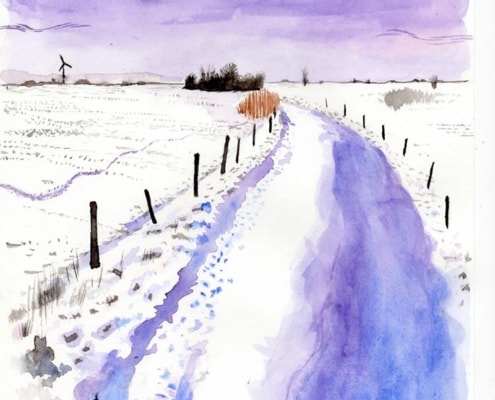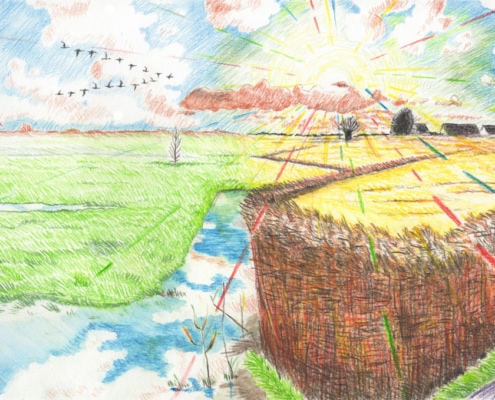Inscendence & inscendental art
Definitions
transcend
from trans “across, beyond” + scandere “to climb”; from PIE *skand
= to spring, leap, climb beyond
transcendence
= the quality or state of excelling, surmounting, moving beyond or above the range of normal or physical human experience
inscendence
= quality or process of going into nature (inner nature/one’s body and outward nature/the external world), into full experience,
toward wholehearted participation (& toward holoflux)
inscendental art (IA)
= art that offers pathways of primal, generative imagination toward the inscendental, i.e. the possible human experiences of inscendence (including a taste of holoflux);
Short definitions of IA
distance removal (visually, emotionally, spatially, …)
primal participation (as with music, cognitive and precognitive)
visceral meaning-immersing (facilitating an erotics of art, not a hermeneutics!*)
Description
The problem with transcendence
In many contexts transcendence is considered a goal, a desired state, whether it be overcoming the “ego” or surmounting the “physical” or “material” limitations. Very frequently the state of one’s body is actually denied in the process.
Religious followers, spiritual seekers, transhumanists, virtual reality adepts, …, commonly pursue some form of transcendence i.e. an escape.
This is highly problematic since it does not confront the world’s many problems at hand, on the contrary, it creates inner division and it cultivates resignation and passivity.
Transcendence is good if it is just a phase, it can be insightful, but transcendence without grounding and effects on our whole organism, has little meaning.
The shortcomings of transcendental art
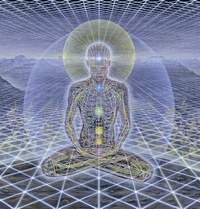
© Alex Grey
Transcendental art definitely has its merits.
However, it is a mix of fantasy, felt experience and/or hypothesis. It usually generates distance for the observer because the images are out of reach or hard to fathom.
As the transcendental picture is not directly accessible, it easily becomes artificial, superfluous eye candy, an aesthetic work of science fiction.
Purely mental identification with a fantasy image is a limited affair.
Transcendental art is not to be rejected, we just want to complement with more accessible ways of depicting.
What is inscendence?
When we inscend, we take a step back or down,
returning to our inborn nature, our pre-rational core.
Inscending involves a more contextual, intuitive approach to life and our surroundings,
rooted in the physical world (body and wider environment/context).
It is an inner process of connection, relation, integration.
It involves equanimity with all that is, both joyful and painful.
It affects awareness, agency and responsibility.
One could also say that inscendence is finding transcendence in ordinary, everyday life, which fundamentally alters one’s daily reality.
Inscendence could prove indispensable to fully confront the ecological crisis, the climate emergency and the crisis of meaning.
Inscendental art
Inscendental art aspires to close or narrow the gap between the mind’s eye and the world and the body.
Pictures/forms that have a directness, a liveliness to them, so that one feels moved to join in and participate, empathize, sympathize, feel compassionate.
During the creation process, subject and object are undivided. Becoming one with the subject matter they are trying to depict, the artist (and viewer?) are in a wildly creative yet subtle zone of impressions, intuitions and expressions.
Inscendental art is meant to spark insight into the infinite richness of nature and the world, altering primary perception in the observer. A work of art can make us look differently at the world after seeing it, even altering our conception of what we consider reality. David Hockney’s later landscape work is a great example of this, bringing out aspects of color and spatiality that elude many of us.
Essential to this key feature is the artist’s ardor to look more attentively and to become aware of their primal, generative imagination, i.e. how images are formed unconsciously by body and mind, which in turn can inspire new ways of imagining and capturing the fruits on canvas/paper/clay/…
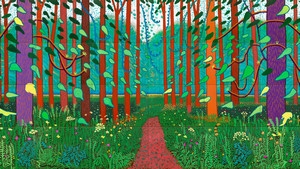
© David Hockney Foundation
Inscendental art is usually a combination of abstraction and photographic elements, it is the merging of abstraction and naturalism, more akin to how we actually perceive the world, could perceive the world differently and how we can participate in/with it. It tries to unlock human imaginative potential.
It aims to question what is considered “real” or “realistic”, breaking away from the ubiquitous conventions of linear perspective and photography. This is why we came up with the term ‘phorography‘, to push the importance of ‘phororealism’
As remarked by David Hockney, in Chinese painting it is said that you need the eye, the heart and the hand to create great works. Two will not do.
More info in the FAQ below.
Related notions/concepts
“contexting” &“generative imagination” (Hoorne)
“shinjin datsuraku” (Eihei Dōgen)
“final participation” (Owen Barfield)
“proprioception of thought” (David Bohm)
“holoflux/holomovement” (David Bohm)
“rheosoma” (Lee Nichol)
“attunement through the body” (Shigenori Nagatomo)
“eutierria” (Glenn A. Albrecht)
“(Inscendence is ) the impulse not to rise above the world (transcendence)
but to climb into it, seek its core.” (Thomas Berry)
Frequently Asked Questions
Is this inscendental art something new?

No, this lively, participative quality has existed for a very long time.
It is present in Chinese and Japanese prints and paintings, in certain comic strips, in art movements from the past (impressionism, post-impressonism, cubism, …), and it goes back to paintings and hand stencils made by Neanderthal people about 40,000 years ago(!).
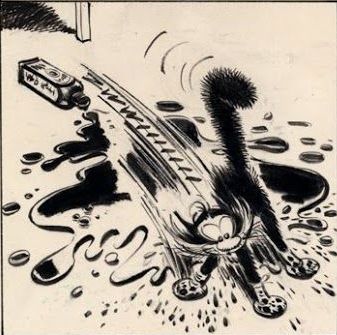
© Franquin
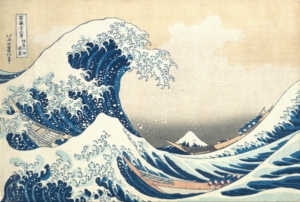
Hokusai
Is inscendental art another art movement?
It could be one some day. The idea of stressing inscendence and the observer’s participation is to highlight a quality that has existed for millennia in human art and human expression.
At first glance, one can see many similarities with Post-Impressionism (which never was a movement anyway, just a label).
However, many Post-Impressionists had an overly subjective approach to their subject matter.
Inscendental art aspires to inscend the subjective and objective approach, integrating them in a holistic approach.
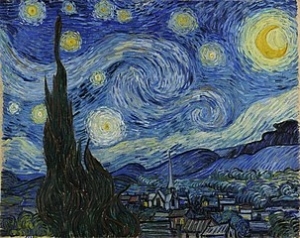 In a way this is a new approach to Realism/Naturalism, but explicitly breaking away from photography (see: phorography).
In a way this is a new approach to Realism/Naturalism, but explicitly breaking away from photography (see: phorography).
From our point of view many of Van Gogh’s paintings are inscendental in nature.
A lot of your artwork does not live up to this inscendental ideal or quality?!!
No doubt! But the artwork is moving more and more in that direction.
Does inscendence require a different sort of imagination?
Inscendence can be reached without imagination, but if art or imagery is involved, a so-called generative imagination is crucial to have a more direct and participative way of engaging, of creatively regenerating or co-generating what one is confronted with.
In other words: a static, photographic perspective cannot resonate with the dynamic actuality of the world (and the artwork, if applicable).
In music, the flowing, ineffable qualities are usually obvious and easy to step into, and in video too to some extent (but the subject-object dichotomy is much more present usually), triggering resonance and fine sensibilities within the listener or viewer. This flux resonance can also be triggered visually, by means of the body and generative imagination.
What’s the connection with your contexting philosophy?
Movement and context are key.
Inscending is the movement toward contexting (a form of generative imagination), since our body is the most immediate context that we can be intimately in touch with. Inscendence is a somatopsychic process where mental subjectivity and body-as-object fall away to a state of somatic agency.
In simple words: intuition, (formerly) unconscious processes broaden perception, and other functions of the organism, the active context informs the organism.
Contexting is participatory
Inscendental art is not an illustration of an idea or a static representation, it attempts to convey a living context in which you can participate (or not)
Do I need to know about this underlying theory to enjoy the artwork?
Not at all! But it can help you what to look at, and to discover inscendental qualities across art movements, throughout art history.
What is the difference between transcendental and inscendental art?
Transcendental art tends to be largely Utopian, depicting altered states of consciousness, idealized image of what the “new age” would look like.
In general, there is even more distance between the viewer and transcendental art than between the viewer and more traditional, naturalist art.
Inscendental art attempts to be actually non-dual in nature, in its generation of form, space, movement and time, by luring the viewer into participation and engagement through creative perception/imagination.
Where does this term ‘inscendence’ come from?
From time to time, we like to come up with new terms. After multiple considerations for a word that described what has been bubbling up in our artwork in recent years, at the same time focused on our issues with the word ‘transcendence’, ‘inscendence’ seemed the most fitting.
A quick internet search showed that someone beat us to it in the late ’90s: Thomas Berry (01914 – 02009), cultural historian and spiritual ecologist.
To our surprise, the meaning he gave to ‘inscendence’ was pretty much in line with our thinking, it broadened our initial perspective even.
What about music? Can music be inscendental?
For sure, music is probably the most potentially inscendental art form out there. Music that feeds the soul and that moves body and mind, that is. It can be found in many genres.



